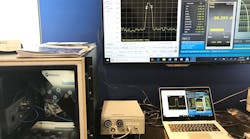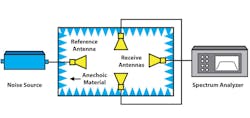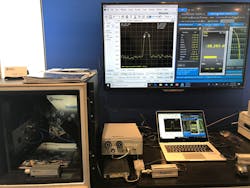Download this article in PDF format.
With 5G communication on its way, over-the-air (OTA) testing has become a focus of many companies throughout the industry. That’s because 5G test methods will almost certainly extend beyond traditional cable-based methods. One firm that has entered into the OTA test fray is Wireless Telecom Group, which demonstrated its own OTA test system at IMS 2018. Wireless Telecom Group is comprised of Boonton Electronics, CommAgility, Microlab, and Noisecom.
Figure 1 shows an illustrated block diagram of an OTA test system. This test system consists of a noise source, a test chamber, antennas, and a spectrum analyzer. In terms of configuration, the noise source located outside the chamber is connected to a transmit antenna within the chamber. The receive antennas inside the chamber are connected to a spectrum analyzer on the outside.
1. This OTA test system utilizes a calibrated noise source.
Noisecom is emphasizing the suitability of noise sources for OTA testing. The company notes that “making reliable and repeatable measurements inside any chamber requires the chamber—and test system as whole—to be calibrated and quantified.”
Furthermore, Noisecom points out that “noise sources are ideal for this type of calibration process, as they provide a known source with calibrated data points that can be used to determine cable loss, air path loss, antenna efficiency, and total chamber response. After the system is calibrated and quantified, the same noise sources with known characteristics can be used as a reference source for the device under test (DUT) to receive signals.”
Noise sources for OTA testing are also more cost-effective in comparison to more expensive signal generators. Noisecom offers calibrated noise sources that cover all frequencies required for 5G testing in OTA chambers.
Figure 2 shows the OTA test system that Wireless Telecom Group demonstrated at IMS 2018. In this demo, a modified Noisecom NC3200 noise source is driving a 14-dB gain amplifier. The output of the amplifier is connected to the transmitting Vivaldi antenna located inside the test chamber.
2. During Wireless Telecom Group’s OTA test demonstration, which took place at IMS 2018, measurements were made with both a power sensor and spectrum analyzer.
Another Vivaldi antenna inside the chamber functions as the receiving antenna. That antenna is connected to a power divider located outside the chamber. One of the power-divider outputs is connected to a Boonton RTP5006 real-time peak power sensor, while the other is connected to a spectrum analyzer. This test setup therefore allows for simultaneous power-sensor and spectrum-analyzer measurements.
Both the spectrum-analyzer and RTP5006 power-sensor measurements are displayed on the monitor in Fig. 2. The power-sensor display reveals the average power along with a complementary cumulative distribution function (CCDF) curve.
When driving the amplifier into compression, the average power measurements obtained from the spectrum analyzer and power sensor correspond with one other. However, the peak power decreases, which can be determined by the CCDF analysis.
“The point we are making is that power sensors are great at seeing the reduction of crest factor and complement spectrum analyzers and vector network analyzers,” says Matt Diessner, regional sales director at Wireless Telecom Group.



